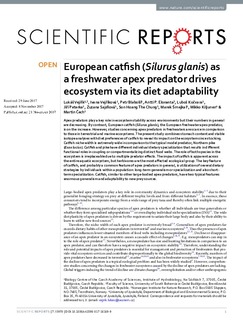European catfsh (Silurus glanis) as a freshwater apex predator drives ecosystem via its diet adaptability
Vejřík, Lukáš; Vejříková, Ivana; Blabolil, Petr; Eloranta, Antti; Kočvara, Luboš; Peterka, Jiří; Sajdlová, Zuzana; The Chung, Son Hoang; Šmejkal, Marek; Kiljunen, Mikko; Cech, Martin
Journal article, Peer reviewed
Published version

Åpne
Permanent lenke
http://hdl.handle.net/11250/2467960Utgivelsesdato
2017Metadata
Vis full innførselSamlinger
- Publikasjoner fra CRIStin - NINA [2364]
- Scientific publications [1392]
Originalversjon
10.1038/s41598-017-16169-9Sammendrag
Apex predators play a key role in ecosystem stability across environments but their numbers in general are decreasing. By contrast, European catfish (Silurus glanis), the European freshwater apex predator, is on the increase. However, studies concerning apex predators in freshwaters are scarce in comparison to those in terrestrial and marine ecosystems. The present study combines stomach content and stable isotope analyses with diet preferences of catfish to reveal its impact on the ecosystem since stocking. Catfish niche width is extremely wide in comparison to the typical model predator, Northern pike (Esox lucius). Catfish and pike have different individual dietary specialization that results in different functional roles in coupling or compartmentalizing distinct food webs. The role of both species in the ecosystem is irreplaceable due to multiple predator effects. The impact of catfish is apparent across the entire aquatic ecosystem, but herbivores are the most affected ecological group. The key feature of catfish, and probably a common feature of apex predators in general, is utilization of several dietary strategies by individuals within a population: long-term generalism or specialization and also shortterm specialization. Catfish, similar to other large-bodied apex predators, have two typical features: enormous generalism and adaptability to new prey sources.
